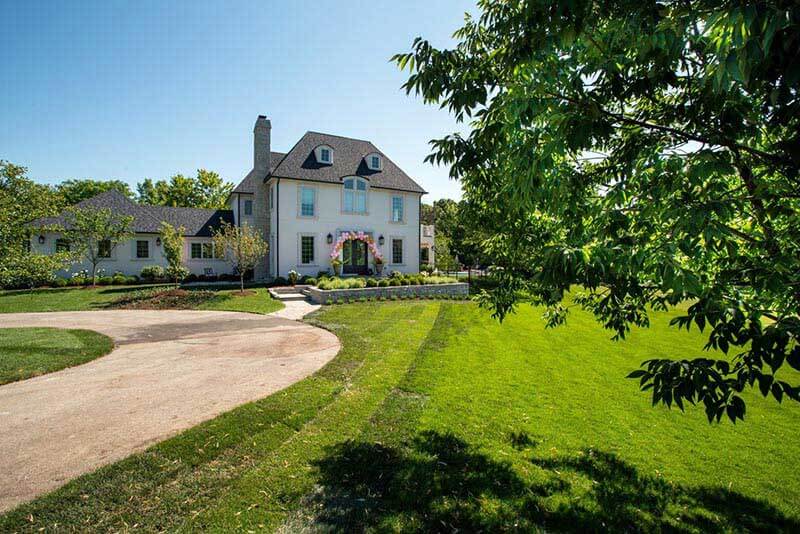1. Consistency
A good landscape has consistency and unity. Repetition brings consistent flow to your design. You can utilize consistency to tie different elements together and create a common vibe or theme. Components used for consistency can include plants, décor, and patterns. Creating unity in your design is vital in creating a cohesive, intentional, and beautiful design.
2. Balance
Balance is also crucial in creating a good landscape design. Balance creates equality and cohesiveness. The two types of balance in the landscape are symmetrical and asymmetrical. Symmetrical balance means two sides of the landscape are identical. Asymmetrical balance means the landscape composition is balanced using different elements and objects with similar imaginary weights. The two types of landscape balance can suit your needs and help you create something extraordinary.
3. Contrast and Harmony
Contrast helps some aspects of your design stand out, while harmony creates cadence and unity in your design. Contrast is a powerful element in design and can draw attention to specific focal points. You can achieve contrast and balance with side-by-side displays of heights, textures, and complementary colors. Make sure to be intentional with your contrasting elements. You can look up simplified landscape designs that can help you inspire in creating your unique yard.
4. Good Color
Color is everything in landscaping. Landscapers are very strategic in the colors they recommend and choose. We use different colors for different reasons. Warm colors such as red and orange may make objects appear closer than they are. You might use cool colors such as blues and greens to make things seem further away. Cool colors are also used to create perspective.
5. Transition
Transitions are gradual changes in landscaping elements. Transitions are created by gradually varying a plant’s size or color vibrancy. Transitions are also used with textures, foliage shapes, and the size of different elements.
6. Lines
Lines are such a powerful tool in landscaping. We love lines. Lines are used in many different ways, including creating beds, walkways, texture, perspective, etc. You can strategically use lines to create an illusion of depth or distance.
7. Proportion
Proportion is the size of an element in relation to another. It’s essential to consider the proportion of your elements and how they will look together. Proper proportion is necessary for creating an aesthetically pleasing and organized design. It is possible to have too much of a good thing.
8. Repetition
Repetition and unity go hand in hand. It’s good to have different elements in a yard but creating a pattern and repeating elements gives your design a cohesively harmonious feel. Too many random objects will make your design look unplanned and scattered. On the other hand, the overuse of an object can make your design look boring and cluttered. It’s essential to find the right balance.
9. Paths
Paths are a great way to make your landscape practical, usable, and organized. It is also a great way to keep your landscape clean. You can avoid footprints on your lawn and dirt all over your patio by creating paths to walk on. Creating walkways and paths is a great way to get creative and create something beautiful for your garden.
Following these nine essential elements for landscape design will create a solid foundation to build upon as you channel your creativity. With each component, it’s critical to add creativity and originality. We are not big fans of cookie-cutter landscape. We love designs that draw attention and have uniquely beautiful elements.
When it’s time to work on your landscape:
1. Come up with a plan. This means taking the time to understand your property. Take measurements. Map out permanently structured fences, sheds, patios, sidewalks, pools, and your home.
2. Follow the nine design elements. Use the above nine elements as a guide when working out your landscape. Following those elements will help to keep everything visually appealing and cohesive.
3. Begin on the prep work. While you are still in the planning phase, create lines in your area with a garden hose so you can use it to scale how large you want your designs to be and what shapes you’d like to create. Planning is important.
4. Start the planting. When you begin the planting, dig a hole for each plant twice as wide as the container. Fill in around the plant. Put your taller shrubs and trees in the back of your design, so you don’t cover smaller plants or block their sunlight. Then use ground covers to fill the space and create mass. Add annuals and perennials to keep your landscape unique and beautiful throughout the year. Note that you’ll need to replace annuals after their growing season.
5. Complete the look with mulch. This will pull all your elements together and help to protect your roots. Mulch also helps to conserve moisture in the soil, among other benefits. The cherry on top is that mulch helps keep weeds out.
We wish you luck on your landscaping journey. If you follow our advice, you will be able to create something stunning. And, if you need a hand with your landscape renovations in Naperville, give us a call.
9.1. Landscape Design Principles Infographic
Every homeowner dream of having a picturesque yard. Landscaping can help you achieve this goal. The key to nailing your landscape project is learning about the basics of landscaping and also understanding the landscaping misconceptions. It is both an art and a science. Here we have nine essential elements you can follow for an excellent landscape design. We will also help you get started on landscaping. Let’s get started, read on.










